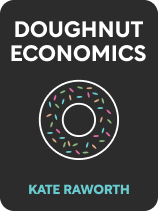

This article is an excerpt from the Shortform book guide to "Doughnut Economics" by Kate Raworth. Shortform has the world's best summaries and analyses of books you should be reading.
Like this article? Sign up for a free trial here .
What is Kate Raworth’s book Doughnut Economics about? What is the key message to take away from the book?
In her book Doughnut Economics, Kate Raworth argues that traditional economic theory has been too focused on the economy as a measure of GDP, income, and output. Raworth proposes redefining how economics is taught and the role that economists play in shaping public policy, shifting from a growth-centered approach to a human-centered approach that harnesses the power of economics for the betterment of humanity.
Below is a brief overview of Doughnut Economics by Kate Raworth.
Redefining the Goal of Economics
Before launching into her exploration of how to redefine the goals and future trajectory of economics, Raworth first guides us through the intellectual underpinnings of the economics field as it currently exists. She writes that, as the field has evolved,
In her book Doughnut Economics, Kate Raworth proposes redefining the field of economics. Specifically, she writes that economics has developed some core assumptions about human nature, what an economy exists to do, and what the social science of economics is meant to achieve. According to her, if the economy is to better serve humanity’s needs, these core assumptions will need to change.
Utility and Growth
Raworth observes that traditional economics places great stock in the concept of utility: the satisfaction or value an individual receives from goods and services. The utility gained is usually synonymous with the price paid.
In her view, this takes too narrow a view of the full range of human needs and desires, since many of our core emotional and spiritual needs can’t be purchased through markets, nor can their value be precisely quantified in monetary terms. These “goods” like love, empathy, childcare, and all other forms of emotional support are essential to the holistic health of the human beings who provide the labor that make the economy function. The providers of such “goods” contributions, while uncompensated financially for their labor, are not secondary to the working of the economy—they are essential to it.
(Shortform note: In What Money Can’t Buy, Michael Sandel echoes Raworth’s argument that it’s impossible to put a price on “goods” like love, empathy, or family. In fact, he argues that applying market values to such areas of the human experience corrupts them. He writes that simply subjecting them to market conditions alters our attitudes toward them and degrades our collective moral and social well-being—forcing us to treat these virtues as mere commodities whose value is reflected in their price instead of having intrinsic, non-monetary value.)
Building off the concept of utility, economists usually argue that the best way to increase human happiness is to boost economic growth to deliver as much utility to as many people as possible. Under this influence, Raworth argues, economic growth has become policymakers’ panacea for all of society’s ills. No matter the problem—poverty, unemployment, crime—economic growth is the solution. Unfortunately, she writes, many of these social problems cannot be addressed by the workings of the market, and in fact, many are exacerbated by the dynamics of unfettered markets.
(Shortform note: Defenders of free markets would argue that Raworth’s concerns about market values ignore the great benefits that capitalism-driven economic growth has delivered to humanity. Some commentators write that the spread of capitalism has been the single most important factor in alleviating global poverty and raising worldwide standards of living. In the 200 years since the dawn of the Industrial Revolution—the period of the strongest economic growth in human history—the share of the world population living in extreme poverty has fallen from 94% to less than 10%.)
The Problem of Unchecked Growth
But, Raworth argues, unchecked economic growth has put us on the wrong side of both the doughnut rings. Despite progress, according to Raworth, we still have too much poverty, food insecurity, lack of opportunity, and other problems of deprivation. Markets may be extraordinarily efficient at distributing resources—through the invisible hand of supply and demand determining which goods are produced, in what quantities, at what price, and who ultimately receives them. However, left unchecked, they will also produce too many harmful by-products (like pollution and inequality) and too few social goods (like health care, education, and clean energy). Moreover, Raworth writes that we have pushed economic growth so far that some bad environmental outcomes may now be unavoidable.
(Shortform note: In The Deficit Myth, Stephanie Kelton similarly writes that our political system has chosen to focus inordinately on purely fiscal deficits (how much the government spends vs. how much revenue it brings in), but is largely unconcerned with social and human deficits—the lack of jobs, ]education, healthcare, and equality of opportunity that are imposing significant suffering on people. Kelton proposes a federal job guarantee to remake the economic order—having the federal government serve as an employer of last resort, guaranteeing the fundamental right to a job for anyone who wants one, and bringing important benefits to the economy and society as a whole.)
Staying Inside the Doughnut
Raworth writes that five factors will determine whether or not we stay within the doughnut (meeting everyone’s basic needs sustainably).
1. Population: The more of us there are, the more of the planet’s resources we’ll consume. Fortunately, Raworth notes, population growth has been falling thanks to improvements in health and well-being that empower women to control family size.
(Shortform note: In Factfulness, authors Hans Rosling, Ola Rosling, and Anna Rosling Rönnlund note that the worldwide average number of babies per woman has halved over the past 50 years, and the world population will settle between 10 billion and 12 billion by 2100. Like Raworth, they largely attribute this to falling family sizes as more of the population rises out of extreme poverty—giving women better access to contraception and creating less of a need to have children since they don’t need more hands for subsistence agriculture.)
2. Inequality: We need a more equitable distribution of what our planet and our economy produce. Raworth writes that problems like food insecurity are not borne of scarcity; they come from a wasteful, inefficient, and unjust spread of the planet’s bounty.
(Shortform note: The data supports Raworth’s assertion that the problems of deprivation are not the result of a lack of resources, but of an inequitable distribution of those resources. Although 270 million people across the world live in near-famine conditions, the planet’s agricultural base is capable of supplying 9 billion metric tons of food a year—2.4 times what it takes to feed every person on the planet.)
3. Vision: We need to have a clear vision of what we consider the necessities for every human being on the planet to lead a fulfilling and comfortable life. Part of the answer, Raworth suggests, may be a move away from rampant consumerism, which is often wasteful and largely exists to display our wealth to others in the form of conspicuous consumption.
(Shortform note: In The Happiness Hypothesis, author Jonathan Haidt argues that conspicuous consumption reduces human happiness by making us strive for the wrong things. When we buy a sports car or a piece of fancy jewelry to show it off to others, we’re engaging in an endless competitive cycle that only devalues the things we buy. Haidt writes that inconspicuous consumption, by contrast, is the kind of spending we do for our benefit, on things that make us intrinsically happy.)
4. Technology: Raworth writes that technologies that provide for social well-being while sustaining the environment—like green infrastructure, renewable energy, and sustainable agriculture—will be critical to our efforts to stay within the doughnut.
(Shortform note: In The Omnivore’s Dilemma, Michael Pollan writes that when it comes to supporting sustainable agriculture, consumers must choose between two alternatives to the corn-based industrial food chain—Big Organic and traditional organic. Big Organic is what supplies big companies like Whole Foods, Walmart, and supermarket chains. Like traditional organic, Big Organic operations avoid pesticides and synthetic fertilizer. But, Pollan warns, they’ve also adopted some practices of the industrial system including mass production, processing, and long-distance distribution. Traditional organic opposes processing and long-distance shipping and aims to sell its foods locally or regionally, while they are freshest.)
5. Government: We need governments at the local, national, and supranational levels to be agile, flexible, and responsive to society’s needs. This means focusing on the common good and sometimes sacrificing local or national concerns, while having the political courage to take on powerful special interests.
(Shortform note: In The Righteous Mind, Jonathan Haidt writes that this concern for the collective good is a facet of morality—and that it is highly culture-dependent. Westerners are individualistic, prioritizing individual rights over the common good. However, most societies subordinate the needs of the individual to the needs of the group—they are sociocentric. Thus, in an individualistic society, it may be more difficult for governments to convince citizens to sacrifice their personal priorities to meet society’s most pressing needs.)
Beyond Homo Economicus
Raworth writes that economics has expanded beyond the original set of concerns we described in the previous chapter. Economics, once focused on the study of the production of goods and services, has branched into psychology and now purports to explain the motivations and beliefs of the human beings who produce those goods and services.
Specifically, Raworth writes that traditional economics has a particular model of human beings: The model is homo economicus, and it asserts that human beings are essentially rational, utility-maximizing entities, able to process, calculate, and have perfect access to information to make the optimal choice for themselves in all situations. It is a portrait of humankind rooted in self-interest, unconcerned with deeper moral imperatives like charity or altruism: Rational economic man cares only about increasing his material wealth and will always follow incentives to do so.
Humans Are Social Beings
Raworth argues that the homo economicus model is a gross and inaccurate caricature of the nuances and complexities of the human condition. Rather than pure utility maximizers, we are highly social beings who prize intangibles like the respect, love, and admiration of our peers. Indeed, our lives abound with examples of reciprocity and altruism with no clear material benefit.
We also don’t perfectly synthesize and process information to make optimal decisions like computers; rather, we rely on estimates, emotions, and heuristics to arrive at our decisions. We are also hopelessly compromised by a slew of cognitive biases that distort our decision-making.
(Shortform note: In Never Split the Difference, former FBI hostage negotiator and negotiation expert Chris Voss writes that the decisions people make during negotiations have little to do with rational decision-making—he argues that good negotiation happens entirely on the emotional level of the brain. A good negotiator understands this and knows how to practice and display empathy toward her counterpart by understanding their emotions, learning to see the situation from their point of view—and, ultimately, getting them to feel comfortable enough with you to let their emotional guard down.)
Extrinsic and Intrinsic Incentives
Raworth writes that this more nuanced portrait of human beings calls into question the widespread use of incentives to nudge and guide our behavior. She argues that extrinsic incentives (when you’re motivated to do something based on the promise of some external reward like money) can often have the perverse effect of crowding out or diminishing more intrinsic incentives (things you are self-motivated to do because you value them for their own sake, not because of the promise of a material reward).
And, Raworth writes, it is those intrinsic incentives that guide many of our more noble and socially beneficial behaviors like caring for our friends and family, participating in civic life, and upholding social and community norms of honesty and trust. Indeed, it is precisely because we are social beings that social incentives and human networks can be more powerful drivers of behavior, as can the actions of figures we admire and respect.
Economy, Society, and Planet: How Systems Interact
Raworth writes that a system is any group of components that interact to form a whole and that, through their interactions, create patterns of behavior. The gravitational pull of bodies in space, the movement of tectonic plates, the actions of buyers and sellers in an economy, and the movement of auto traffic on a crowded street are all systems.
The Economy Is an Open System
To understand how the system of our economy works and how we can make it more responsive to our social and environmental needs, we need to understand how systems interact with other systems.
Raworth observes that traditional economics has a closed-system model for the economy, which operates simply as a series of “inflows” and “outflows” of money, closed off from everything else. This model puts the economy in isolation and treats it as a machine, governed by a simple and predictable set of inputs and outputs.
Raworth argues that this model is deceptively simple and ignores how the economy is actually an open system embedded within larger systems—1) the society and culture within which it operates and 2) the planet itself. The economy is a subsystem operating within a complex set of larger systems like society, politics, evolutionary biology, and climate science—that it both influences and is influenced by.
She writes that the economy cannot exist without society or the planet’s natural resources. The economy depends upon the connections and institutions of our society such as language, government, culture, ethics, morality, and law, as well as the natural resources and energy provided by the planet. The economic events we observe in the world arise out of the interplay within and between complex systems and the feedback loops they create. The economy depends upon the systems that sustain it, such as natural resources, agricultural production, population growth, and a stable society. She argues that if unchecked growth pushes these systems toward collapse, our entire economy and civilization could collapse too.
And because our society and planet give the economy the resources it needs, our economy must be organized to serve and steward them—not the other way around.
The Distributive Economy
Raworth writes that our economic system fails to keep us inside the doughnut because it produces too much inequality—a small minority of the world population has amassed vast fortunes, while billions of people remain mired in extreme poverty.
She argues that inequality is directly linked to social ills—like crime, drug abuse, lack of educational attainment, and low life expectancy—and undermines democratic institutions and social cohesion. Moreover, inequality fuels a feedback loop that leads to more inequality, as the wealthy can use their outsized political power to lobby for economic policies that make them even richer—all while fueling wasteful conspicuous consumption that harms our environment and depletes natural resources. Meanwhile, the ability of a few large players to shift the flows of capital throughout the global economy makes the entire system fragile, unstable, and vulnerable to shocks and bubbles.
In this section, Raworth proposes some concrete solutions to the problem of our inequitable economy: 1) redistributing land resources, 2) getting the money supply out of the hands of governments and central banks, 3) giving workers greater control over the economy’s production and distribution decisions, and 4) rewarding companies for investing in people rather than robots.
Redistributing Land Ownership
To make the economy properly distributive, says Raworth, we need to change who owns property, which is itself wealth-generating. She proposes redistribution of land ownership, giving people an asset they can improve or use as collateral.
She argues that this is fair, because land is often only valuable because of the natural endowments on or near it (which are our collective natural inheritance) or the social improvements made in its vicinity (like roads, schools, and industry), which are paid for by the shared investment and labor of the community.
(Shortform note: Some economists take a dimmer view of redistribution than Raworth. In Capitalism and Freedom, Milton Friedman writes that forced economic redistribution is inherently unjust. He argues that one of the cornerstones of a society based upon voluntary exchange is the right to keep your private property. According to Friedman, there is no moral justification for a majority to compel a minority to hand over its property, whether it’s a gang of armed robbers telling you to hand over the cash in your wallet or a majority of voters passing legislation to legally confiscate wealth from the so-called “1%.”)
Democratizing Money
Besides expanding property ownership, Raworth argues that a truly distributive economy needs to democratize the money supply.
She writes that in a capitalist economy, banks create money by lending it out and earning it back with interest, then lending out more, thereby increasing the money supply. Unfortunately, she argues, entrusting banks to do this comes with some problems—private banks will often use this money-creating power to purchase or invest in assets that already exist, driving up their prices and enriching those who already own them (in many cases, the banks themselves). This drains productive resources away from society.
But this is not the way it has to be. Raworth champions government-backed financial institutions that could take the role of private banks, with a social commitment to invest in low-interest loans for enterprises that benefit society: roads, infrastructure, education, skills training, and the environment. The government could also require banks to hold larger reserves of capital, which would stabilize the financial system and reduce the incentive for banks to ignite giant credit-fueled bubbles that melt down the financial system.
(Shortform note: These sorts of banking reforms championed by Raworth are actually quite similar to steps the Obama administration took to stabilize the banking system in the wake of the 2008 financial crisis. In A Promised Land, Obama discusses his team’s plan to conduct a stress test of the major banks—essentially, a thorough financial audit of the banks’ assets and liabilities, conducted by the Federal Reserve. Under the terms of the stress test, banks were required to hold larger stocks of capital in reserve. They could only receive further bailouts if the stress test found that they could not remain solvent without such an infusion of cash.)
She argues that central banks could also take the even more radical step of issuing new money directly to every household during a recession, creating a people’s monetary policy. Moreover, blockchain technologies like Ethereum and Bitcoin can also democratize and decentralize currency through their system of peer-to-peer exchange on a public ledger that removes intermediaries like banks and other financial institutions.
Reimagining Labor Markets
The next step Raworth suggests for creating a distributive economy is transitioning to a system of employee-owned firms, giving workers an equity stake in the firms to which they supply their valuable labor.
She notes that workers have seen their share of national wealth and their bargaining power decline precipitously since the dawn of the neoliberal era in the 1970s and 1980s. This has happened to varying degrees all over the world, even in highly unionized economies like Germany and the Scandinavian countries. Most firms see their sole purpose as maximizing shareholder value, with labor merely a cost—one to be minimized as much as possible.
(Shortform note: Perhaps the most well-known articulation of this theory came from economist Milton Friedman. In his famous 1970 article for the New York Times Magazine, “The Social Responsibility Of Business Is to Increase Its Profits,” Friedman championed the shareholder value maximization model. This model held that the most important measure of a company’s success was the financial returns to its shareholders. He saw any acts of “corporate social responsibility” as a misuse and expropriation of shareholders’ money on the part of well-intentioned but ultimately misguided corporate officers.)
But, Raworth writes, shareholder equity only exists because of the labor that adds value to the firm’s products and services. To deny workers that same equity stake is to deprive them of what is rightfully theirs. She proposes rewriting corporate charters to implement new and alternative forms of labor organization, such as cooperatives and employee-owned enterprises that will give workers a greater share of national income and reorient the mission of private enterprise itself—from being profit-driven to people-driven.
Adapting to Automation
Finally, Raworth writes that building a people-centered economy requires addressing the challenges of automation.
The economy’s productivity is no longer linked to employment—firms can produce more output with fewer workers, largely thanks to automation. Raworth notes that the trend is no longer confined to blue-collar manufacturing jobs. Even white-collar professional “knowledge economy” work is increasingly being cannibalized by software and AI. This presents a major social problem as an ever-growing share of the population may find itself without any useful labor to sell.
Raworth proposes using the tax code to shift the incentives for businesses. Right now, businesses have to pay payroll taxes for human workers, but can write off investments in robots and other automation technology as a business expense—the government is, in effect, subsidizing automation. Raworth recommends taxing automation and rewarding firms for investing in humans.
She also champions giving citizens a stake in the private gains accrued by technology companies—gains that are often only possible because of the initial public investment in the underlying technologies. Raworth writes that this could take the form of public redistributed royalties from companies that benefited from taxpayer investments or from their use of public assets.
(Shortform note: Although Raworth proposes giving the public a stake in technology companies because of historical government investments in technology, she doesn’t acknowledge just how far-reaching the implications of this could be. Using her logic, any company that harnesses the technology of the internet—which, today, is all companies—would have to cede an equity stake to the government. This is because the technology that created the internet itself traces its earliest roots to US government research in the 1960s, when Pentagon analysts created ARPANET—the protocol that formed the base of today’s internet.)
The Regenerative Economy
Raworth writes that we need a top-to-bottom redesign of our global economic order: away from an extractive economy and toward a regenerative economy.
We’ve already explored Raworth’s argument that on a global scale, unchecked growth leads to more and more environmental degradation. She writes that this is because our economy is inherently depletive and extractive: It consumes energy and materials to make products, which are then used and discarded, creating waste. The resources used are not replaced.
(Shortform note: The evidence suggests that the problems of our wasteful economy are only getting worse. According to the World Bank, the planet is on pace to generate 70% more waste by 2050—more than doubling the projected growth rate of the population itself during that time. This makes sense, as waste generation is closely tied to levels of economic growth and disposable income—as the world gets richer and the global economy gets more productive, we’re generating more waste per person. This is the dark side of economic development, as governments around the world struggle to cope with the rising tide of waste and garbage—93% of which is openly dumped or burned.)
The Circular Production Model
Raworth argues that companies need to shift their mindset and accept that their continued profitability depends on the survival of our environmental and social commons—a skilled workforce, clean air and water, and access to food, to name a few. If they take and take without replenishing or regenerating, there will be nothing left.
Standard environmental policy solutions like carbon-neutral or net-zero emissions targets are a good start, writes Raworth, but the regenerative economy can go even further. Beyond just doing no harm, companies need to do positive good—making replenishment a core component of the business model, mimicking the self-renewing processes of nature.
This means shifting toward a circular production model in which the biological and technological components of production are reused in the next cycle of production—breaking the linear “make, consume, discard” model. Raworth writes that doing so will keep our economy in the right part of the doughnut—eliminating environmental waste, while creating new jobs for people to steward and maintain this system of sustainable production.
Raworth writes that the shift toward a regenerative economy does not need to be anti-business—in fact, recovering used resources and recycling them for future production can be highly profitable. A major reason for this is the major cost savings on source materials—it would be far cheaper to regenerate existing materials than to extract new ones.
Using the Power of the State
Raworth writes that the regenerative economy requires harnessing the power of the state—having the government reward investment in people and renewable resources.
As we’ve seen Raworth argue, fiscal policies in most developed countries tax labor and reward automation, with labor subject to the payroll tax while robots are a tax-deductible capital investment. By the same token, she notes, governments levy comparatively little on the non-renewable, common resources like land, air, and water that corporations exploit for private gain. The effect has been to subsidize and incentivize industry toward a profit-maximizing, environment-destroying, labor-exploiting posture.
Instead, the state can be a partner, using its fiscal power and the fact that it does not need to earn a profit to make the needed environmental and social investments that the private sector can’t or won’t.
Human Prosperity Over Economic Growth
Raworth’s closing argument is that we need to move beyond economic growth as the primary measure of the health of our economy and society. Human happiness, prosperity, and the health of our ecosystem and biosphere—staying inside the “dough” of the doughnut—are what matter most, whether growth happens or not.
She argues that there must be some natural growth boundary based on an economy’s limited endowments of labor, land, capital, natural resources, space, knowledge, technology, and other factors of production. In other words, growth cannot go on forever. In many respects, this is already happening in rich countries as they grapple with an aging population, slow population growth, and declining worker productivity.
Long-Term Growth Is Unsustainable
Raworth warns that it may simply be the case that absolute growth is incompatible with staying inside our ecological boundaries—especially as we face the prospect of runaway global warming fueled by greenhouse gas emissions.
The No-Growth Future
According to Raworth, we need to think about and plan for a no-growth future. This involves a complete reimagining of many of our core assumptions about the goals and needs of our society, as the strategies of businesses, households, and governments are all centered on continued economic growth.
But, she writes, the end of growth need not spell disaster. Indeed, our economy can continue to prosper and develop even if it isn’t growing. Raworth suggests some ideas for how we can build the post-growth economy:
1. Negative-interest currency: This is money that loses value over time and can’t be hoarded. Raworth argues that this incentivizes holders to invest in low- or no-growth enterprises that are socially or environmentally redeeming, since there’s no reason to hold onto money. This would tilt the scale toward long-term investment in the regenerative economy, where returns are lower and longer in outlook—but would fuel the social, cultural, environmental benefits we need.
(Shortform note: Having governments issue an entirely new currency that loses its value over time may be a needlessly complicated way to achieve the kind of long-term investments that Raworth champions. It’s not clear how much value the currency would lose and on what timescale, nor is it established who would make these decisions—would the depreciation schedule be established by statute or would central banks control this policy? Alternatively, the central bank could simply lower interest rates on the existing currency to negative levels. In fact, it’s not such a radical idea—countries including Switzerland, Sweden, Denmark, and Japan have already instituted negative interest rates.)
2. Tax reform: We need to crack down on tax havens and evasion, stop taxing labor and income streams, and start taxing accumulated wealth through progressive inheritance, land, and capital gains taxes. Once we do this, Raworth writes, we can use the tax code to reward employers for hiring and investing in people and workers’ skills.
(Shortform note: In Capital in the Twenty-First Century, Thomas Piketty proposes a global wealth tax as a potential check on soaring inequality. Such a tax would be progressive, with higher fortunes taxed at a higher marginal rate than smaller fortunes. Piketty argues that the purpose of the tax would not be to raise revenue. Instead, its purpose would be to stop the unchecked accumulation of wealth by the global hyper-wealthy, end the financial opacity that allows so much of the world’s wealth to exist in the shadows, and redistribute economic resources.)
3. Break the culture of consumerism: We define ourselves by our material lifestyle and what we buy. We are psychologically rooted to the idea of growth because it gives hope: that we’ll be richer, more comfortable, and have higher relative social standing. But, Raworth writes, this is hardly a universal trait of human cultures—it is a specific cultural by-product of hyper-capitalist societies. In fact, other cultures across the world and throughout history have been less acquisitive and more focused on sufficiency and satisfaction. We can even start to move away from the culture of rampant consumerism in small ways, such as by banning advertising in public places.
(Shortform note: Some commentators argue that the buying public is already moving away from the pattern of mass consumption that has been the engine of the past three centuries of economic growth. They write that consumers are becoming more environmentally conscious and are starting to think about the ecological impact of what they buy, how much they buy, and how long it lasts. This awareness of the production and consumption cycle on the part of buyers poses a genuine threat to the consumerism model—evidence of which can be seen in the notable decline of the retail sector.)

———End of Preview———
Like what you just read? Read the rest of the world's best book summary and analysis of Kate Raworth's "Doughnut Economics" at Shortform .
Here's what you'll find in our full Doughnut Economics summary :
- Why we need a top-to-bottom redesign of our global economic order
- Why long-term economic growth is unsustainable
- How inequality fuels a feedback loop that leads to more inequality






